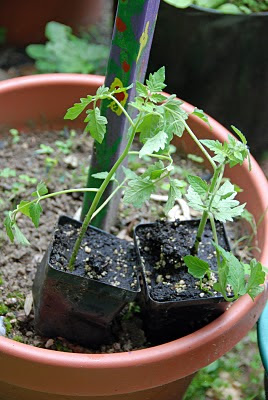 Digitalis (foxglove) has burst into bloom all around our house. It is a biennial plant that only blooms in its second year, before leaving seeds and dying. I don't think we ever planted digitalis; our annual display must be courtesy of the local birds spreading seeds.
Digitalis (foxglove) has burst into bloom all around our house. It is a biennial plant that only blooms in its second year, before leaving seeds and dying. I don't think we ever planted digitalis; our annual display must be courtesy of the local birds spreading seeds.Foxglove is a fairly toxic plant. It can cause nausea, blurred vision, and vomiting. But despite these symptoms, some folk healers have considered it a medicinal plant, and in the 18th century Digitalis became one of the first medicines to be used (as an effective medication for heart disease) by modern medicine.
I also put most of this year's tomato plants into the ground this weekend. We have become enormously enamored of "Sun Gold" tomatoes, a variety of cherry tomato that is amazingly prolific, sweet and tasty.
 You've got to wonder, though: What possessed anyone, hundreds of years ago, to decide to put these things in their mouths? Digitalis makes people sick; but somehow someone figured out that at some exact dosage, Digitalis could make certain sick people well.
You've got to wonder, though: What possessed anyone, hundreds of years ago, to decide to put these things in their mouths? Digitalis makes people sick; but somehow someone figured out that at some exact dosage, Digitalis could make certain sick people well.
Tomatoes are in the nightshade family, which includes the pesky plant that grows locally here called "Deadly Nightshade" or Belladonna. Every part of the Deadly Nightshade is severely toxic, to the point that ingestion of a small amount of root, leaf or berries can be fatal. And yet European explorers brought Belladonna's cousin, the tomato, back from South America.
There are so many ways in which our "modern" lives are built on the sacrifices and even the mistakes of our ancestors. When the first pint of delicious Sun Gold tomatoes reaches my table next month, you know I'll be thinking about the unknown South American hero who long ago had the courage to pop a tomato in her or his mouth, not knowing if it would bring illness or health.
No comments:
Post a Comment